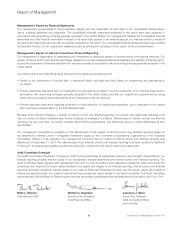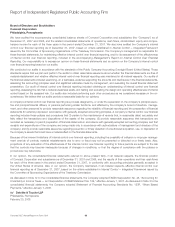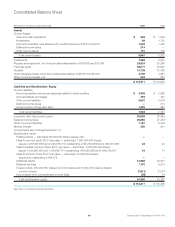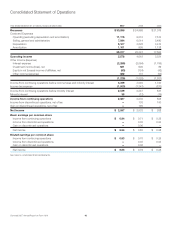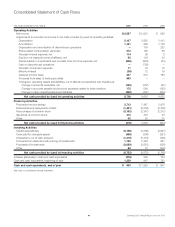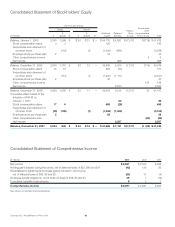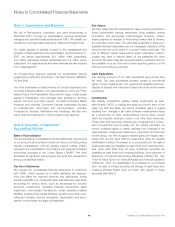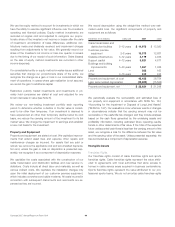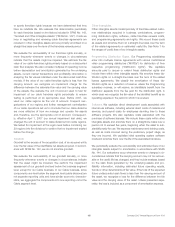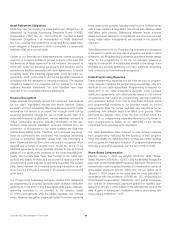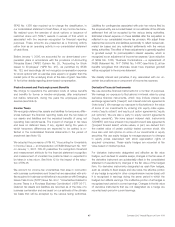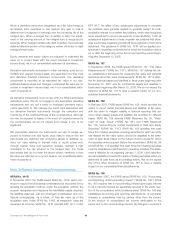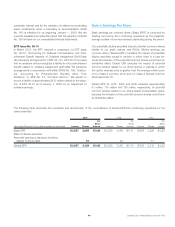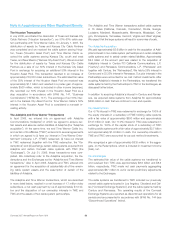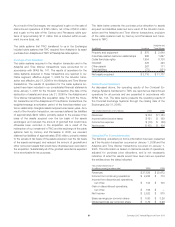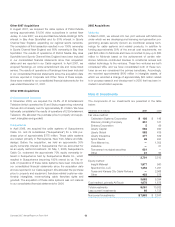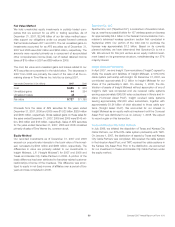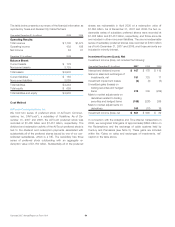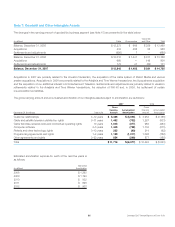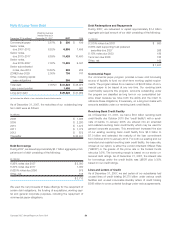Comcast 2007 Annual Report Download - page 48
Download and view the complete annual report
Please find page 48 of the 2007 Comcast annual report below. You can navigate through the pages in the report by either clicking on the pages listed below, or by using the keyword search tool below to find specific information within the annual report.Asset Retirement Obligations
SFAS No. 143, “Accounting for Asset Retirement Obligations,” as
interpreted by Financial Accounting Standards Board (“FASB”)
Interpretation (“FIN”) No. 47, “Accounting for Conditional Asset
Retirement Obligations — an Interpretation of FASB Statement
No. 143,” requires that a liability be recognized for an asset retire-
ment obligation in the period in which it is incurred if a reasonable
estimate of fair value can be made.
Certain of our franchise and lease agreements contain provisions
requiring us to restore facilities or remove property in the event that
the franchise or lease agreement is not renewed. We expect to
continually renew our franchise agreements and therefore cannot
estimate any liabilities associated with such agreements. A remote
possibility exists that franchise agreements could terminate un-
expectedly, which could result in us incurring significant expense in
complying with the restoration or removal provisions. The disposal
obligations related to our properties are not material to our con-
solidated financial statements. No such liabilities have been
recorded in our consolidated financial statements.
Revenue Recognition
Cable revenues are primarily derived from subscriber fees received
for our video, high-speed Internet and phone services (“cable
services”) and from advertising. We recognize revenues from cable
services as the service is provided. We manage credit risk by
screening applicants through the use of credit bureau data. If a
subscriber’s account is delinquent, various measures are used to
collect outstanding amounts, including termination of the sub-
scriber’s cable service. Installation revenues obtained from the
connection of subscribers to our cable systems are less than
related direct selling costs. Therefore, such revenues are recog-
nized as connections are completed. We recognize advertising
revenue at estimated realizable values when the advertising is
aired. Revenues earned from other sources are recognized when
services are provided or events occur. Under the terms of our
franchise agreements, we are generally required to pay an amount
based on our gross video revenues to the local franchising au-
thority. We normally pass these fees through to our cable sub-
scribers and classify the fees as a component of revenues with the
corresponding costs included in operating expenses. We present
other taxes imposed on a revenue producing transaction as rev-
enue if we are acting as a principal or as expense if we are acting
as an agent.
Our Programming businesses recognize revenue from distributors
as programming is provided, generally under multiyear distribution
agreements. From time to time these agreements expire while pro-
gramming continues to be provided to the operator based
on interim arrangements while the parties negotiate new contract
terms. Revenue recognition is generally limited to current payments
being made by the operator, typically under the prior contract terms,
until a new contract is negotiated, sometimes with effective dates
that affect prior periods. Differences between actual amounts
determined upon resolution of negotiations and amounts recorded
during these interim arrangements are recorded in the period of
resolution.
Advertising revenue for our Programming businesses is recognized
in the period in which commercials or programs are aired. In some
instances, our Programming businesses guarantee viewer ratings
either for the programming or for the commercials. Revenue is
deferred to the extent of an estimated shortfall in the ratings. Such
shortfalls are primarily settled by providing additional advertising
time, at which point the revenue is recognized.
Cable Programming Expenses
Cable programming expenses are the fees we pay to program-
ming networks to license the programming we package, offer and
distribute to our cable subscribers. Programming is acquired for
distribution to our cable subscribers, generally under multiyear
distribution agreements, with rates typically based on the number
of subscribers that receive the programming, channel positioning
and penetration factors. From time to time these contracts expire
and programming continues to be provided based on interim
arrangements while the parties negotiate new contractual terms,
sometimes with effective dates that affect prior periods. While
payments are typically made under the prior contract terms, the
amount of our programming expenses recorded during these in-
terim arrangements is based on our estimates of the ultimate
contractual terms expected to be negotiated.
Our cable subsidiaries have received or may receive incentives
from programming networks for the licensing of their program-
ming. We classify the deferred portion of these fees within liabilities
and recognize the fees as a reduction of programming expenses
(included in operating expenses) over the term of the contract.
Share-Based Compensation
Effective January 1, 2006, we adopted SFAS No. 123R, “Share-
Based Payment” (“SFAS No. 123R”), using the Modified Prospective
Approach. Under the Modified Prospective Approach, the amount of
compensation cost recognized includes: (i) compensation cost for all
share-based payments granted before but not yet vested as of
January 1, 2006, based on the grant date fair value estimated in
accordance with the provisions of SFAS No. 123, “Accounting for
Stock-Based Compensation” (“SFAS No. 123”) and (ii) compensa-
tion cost for all share-based payments granted or modified sub-
sequent to January 1, 2006, based on the estimated fair value at the
date of grant or subsequent modification date in accordance with
the provisions of SFAS No. 123R.
Comcast 2007 Annual Report on Form 10-K 46



